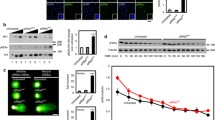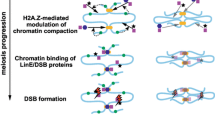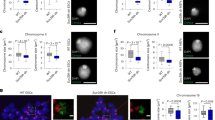Abstract
RbAp46/48, histone chaperone, is a family of evolutionarily conserved WD40 repeat-containing proteins, which are involved in various chromatin-metabolizing processes, but their in vivo functional relevance is yet unclear. In order to examine the biological role of pRbAp48 in chicken DT40 cells, we generated a tetracycline-inducible system for conditional RbAp48-knockout cells. Depletion of RbAp48 led to delayed S phase progression associated with slow DNA synthesis and nascent nucleosome formation, followed by accumulation in G2/M phase, finally leading to cell death. Prior to cell death, these cells exhibited aberrant mitosis such as highly condensed and abnormal chromosome alignment on the metaphase plate, leading to chromosome missegregation. Depletion of RbAp48 also caused dissociation of heterochromatin protein 1 (HP1) from pericentromeric heterochromatin. Furthermore, depletion of RbAp48 from cells led to elevated levels of acetylation and slightly decreased levels of methylation, specifically at Lys-9 residue of histone H3. These results suggest that RbAp48 plays an important role in chromosome stability for proper organization of heterochromatin structure through the regulation of epigenetic mark.





Similar content being viewed by others
Abbreviations
- CAF-1:
-
Chromatin assembly factor
- HP1:
-
Heterochromatin protein 1
- Rb:
-
Retinoblastoma
- HAT:
-
Histone-acetyltransferase
- HDAC:
-
Histone deacetylase
- HMT:
-
Histone methyltransferase
References
Adam S, Polo SE, Almouzni G (2014) How to restore chromatin structure and function in response to DNA damage—let the chaperones play. FEBS J 281:2315–2323
Anderson AE, Karandikar UC, Pepple KL, Chen Z, Bergmann A, Mardon G (2011) The enhancer of trithorax and polycomb gene Caf1/p55 is essential for cell survival and patterning in Drosophila development. Development 138:1957–1966
Barman HK, Takami Y, Ono T, Nishijima H, Sanematsu F, Shibahara K, Nakayama T (2006) Histone acetyltransferase 1 is dispensable for replication-coupled chromatin assembly but contributes to recover DNA damages created following replication blockage in vertebrate cells. Biochem Biophys Res Commun 345:1547–1557
De Koning L, Corpet A, Haber JE, Almouzni G (2007) Histone chaperones: an escort network regulating histone traffic. Nat Struct Mol Biol 14:997–1007
Fukagawa T, Earnshaw WC (2014) The centromere: chromatin foundation for the kinetochore machinery. Dev Cell 30:496–508
Fukagawa T, Mikami Y, Nishihashi A, Regnier V, Haraguchi T, Hiraoka Y, Sugata N, Todokoro K, Brown W, Ikemura T (2001) CENP-H, a constitutive centromere component, is required for centromere targeting of CENP-C in vertebrate cells. EMBO J 20:4603–4617
Gossen M, Bujard H (1992) Tight control of gene expression in mammalian cells by tetracycline-responsive promoters. Proc Natl Acad Sci U S A 89:5547–5551
Hayashi T, Fujita Y, Iwasaki O, Adachi Y, Takahashi K, Yanagida M (2004) Mis16 and Mis18 are required for CENP-A loading and histone deacetylation at centromeres. Cell 118:715–729
Hennig L, Taranto P, Walser M, Schonrock N, Gruissem W (2003) Arabidopsis MSI1 is required for epigenetic maintenance of reproductive development. Development 130:2555–2565
Kadyrova LY, Rodriges Blanko E, Kadyrov FA (2013) Human CAF-1-dependent nucleosome assembly in a defined system. Cell Cycle 12:3286–3297
Kaufman PD, Kobayashi R, Stillman B (1997) Ultraviolet radiation sensitivity and reduction of telomeric silencing in Saccharomyces cerevisiae cells lacking chromatin assembly factor-I. Genes Dev 11:345–357
Kelly TJ, Qin S, Gottschling DE, Parthun MR (2000) Type B histone acetyltransferase Hat1p participates in telomeric silencing. Mol Cell Biol 20:7051–7058
Kwon SH, Workman JL (2008) The heterochromatin protein 1 (HP1) family: put away a bias toward HP1. Mol Cell 26:217–227
Kwon MS, Hori T, Okada M, Fukagawa T (2007) CENP-C is involved in chromosome segregation, mitotic checkpoint function, and kinetochore assembly. Mol Biol Cell 18:2155–2168
Mejlvang J, Feng Y, Alabert C, Neelsen KJ, Jasencakova Z, Zhao X, Lees M, Sandelin A, Pasero P, Lopes M, Groth A (2014) New histone supply regulates replication fork speed and PCNA unloading. J Cell Biol 204:29–43
Muller J, Hart CM, Francis NJ, Vargas ML, Sengupta A, Wild B, Miller EL, O’Connor MB, Kingston RE, Simon JA (2002) Histone methyltransferase activity of a Drosophila polycomb group repressor complex. Cell 111:197–208
Nestorov P, Tardat M, Peters AH (2013) H3K9/HP1 and polycomb: two key epigenetic silencing pathways for gene regulation and embryo development. Curr Top Dev Biol 104:243–291
Nowak AJ, Alfieri C, Stirnimann CU, Rybin V, Baudin F, Ly-Hartig N, Lindner D, Muller CW (2011) Chromatin-modifying complex component Nurf55/p55 associates with histones H3 and H4 and polycomb repressive complex 2 subunit Su(z)12 through partially overlapping binding sites. J Biol Chem 286:23388–23396
Quivy JP, Roche D, Kirschner D, Tagami H, Nakatani Y, Almouzni G (2004) A CAF-1 dependent pool of HP1 during heterochromatin duplication. EMBO J 23:3516–3526
Robbins AR, Jablonski SA, Yen TJ, Yoda K, Robey R, Bates SE, Sackett DL (2005) Inhibitors of histone deacetylases alter kinetochore assembly by disrupting pericentromeric heterochromatin. Cell Cycle 4:717–726
Sanematsu F, Takami Y, Barman HK, Fukagawa T, Ono T, Shibahara K, Nakayama T (2006) Asf1 is required for viability and chromatin assembly during DNA replication in vertebrate cells. J Biol Chem 281:13817–13827
Scuto A, Zhang H, Zhao H, Rivera M, Yeatman TJ, Jove R, Torres-Roca JF (2007) RbAp48 regulates cytoskeletal organization and morphology by increasing K-Ras activity and signaling through mitogen-activated protein kinase. Cancer Res 67:10317–10324
Smith S, Stillman B (1989) Purification and characterization of CAF-I, a human cell factor required for chromatin assembly during DNA replication in vitro. Cell 58:15–25
Takami Y, Kikuchi H, Nakayama T (1999) Chicken histone deacetylase-2 controls the amount of the IgM H-chain at the steps of both transcription of its gene and alternative processing of its pre-mRNA in the DT40 cell line. J Biol Chem 274:23977–23990
Takami Y, Ono T, Fukagawa T, Shibahara K, Nakayama T (2007) Essential role of chromatin assembly factor-1-mediated rapid nucleosome assembly for DNA replication and cell division in vertebrate cells. Mol Biol Cell 18:129–141
Verreault A, Kaufman PD, Kobayashi R, Stillman B (1996) Nucleosome assembly by a complex of CAF-1 and acetylated histones H3/H4. Cell 87:95–104
Verreault A, Kaufman PD, Kobayashi R, Stillman B (1998) Nucleosomal DNA regulates the core-histone-binding subunit of the human Hat1 acetyltransferase. Curr Biol 8:96–108
Zhang Y, Iratni R, Erdjument-Bromage H, Tempst P, Reinberg D (1997) Histone deacetylases and SAP18, a novel polypeptide, are components of a human Sin3 complex. Cell 89:357–364
Zhang Y, Ng HH, Erdjument-Bromage H, Tempst P, Bird A, Reinberg D (1999) Analysis of the NuRD subunits reveals a histone deacetylase core complex and a connection with DNA methylation. Genes Dev 13:1924–1935
Acknowledgments
This work was supported in part by Grant-in-Aid for Scientific Research from the Ministry of Education, Culture, Sports, Science and Technology of Japan. We thank Ryoko Masuya and Nahoko Nagamatsu-Yamamoto for their technical assistance and Radha Madhyastha and HarishKumar Madhyastha for useful comments and critical reading of the manuscript.
Author information
Authors and Affiliations
Corresponding author
Ethics declarations
Conflict of interest
All the authors declare that they have no conflict of interest of any sort with anyone.
Additional information
Responsible Editor: Job Dekker.
Electronic supplementary material
Below is the link to the electronic supplementary material.
Supplementary file 1
The live-cell observation was started at 36 h after plating the conditional RbAp48-knockout cells, endogenously tagged with DsRed and EGFP in the normal condition (without tet), and time-lapse images were taken every 20 min for the next 23 h. Time is shown as hours:minutes after addition of tet. Left panel, phase contrast; center panel, CENPH-GFP; right panel, HP1γ–DsRed. (AVI 2162 kb)
Supplementary file 2
The live-cell observation was started at 36 h after plating the conditional RbAp48-knockout cells, endogenously tagged with DsRed and EGFP in the presence of tet, and time-lapse images were taken every 20 min for the next 23 h. Time is shown as hours:minutes after addition of tet. Left panel, phase contrast; center panel, CENPH-GFP; right panel, HP1γ–DsRed. (AVI 2345 kb)
Rights and permissions
About this article
Cite this article
Satrimafitrah, P., Barman, H.K., Ahmad, A. et al. RbAp48 is essential for viability of vertebrate cells and plays a role in chromosome stability. Chromosome Res 24, 161–173 (2016). https://doi.org/10.1007/s10577-015-9510-8
Received:
Revised:
Accepted:
Published:
Issue Date:
DOI: https://doi.org/10.1007/s10577-015-9510-8




